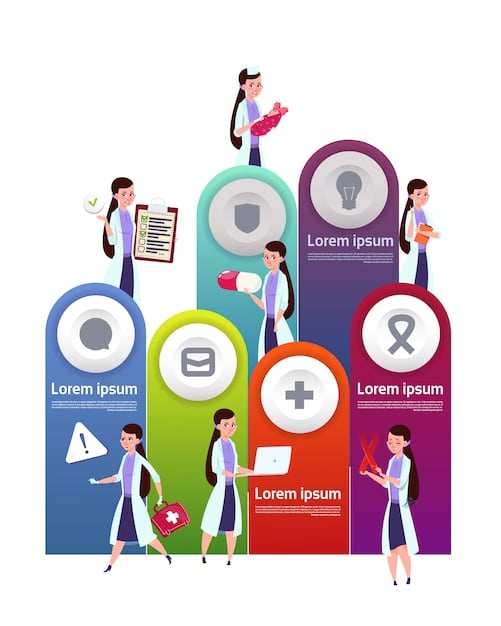Gen Z Healthcare Gap: Medicaid & ACA Expansion to Cut Uninsured by 15% in 2025?

The expansion of Medicaid and Affordable Care Act (ACA) coverage is poised to significantly impact uninsured rates among Gen Z by 2025, potentially achieving a 15% reduction through enhanced accessibility, affordability, and streamlined enrollment processes tailored to their unique circumstances and healthcare needs.
The landscape of healthcare coverage for young Americans has always been a complex one, but for Addressing the Healthcare Gap for Gen Z: Will the Expansion of Medicaid and Affordable Care Act Coverage Reduce Uninsured Rates by 15% in 2025? It is a question that reverberates through policy discussions, economic forecasts, and most importantly, the lives of millions of young people across the United States. This generation, often characterized by its digital native status and unique socio-economic pressures, faces distinct challenges in accessing affordable health insurance. Understanding whether current legislative efforts and expanding coverage options can genuinely bridge this gap and meet ambitious targets is crucial. Let’s delve into the intricacies of this challenge and the potential solutions.
Understanding the Healthcare Landscape for Gen Z
Generation Z, broadly defined as individuals born between the late 1990s and early 2010s, represents a significant portion of the current and future workforce. Their healthcare needs are distinct, often characterized by a greater emphasis on mental health services, reproductive care, and preventative medicine. However, their entry into the adult world often coincides with precarious employment situations, student debt, and a general lack of understanding about navigating complex insurance systems. Many are transitioning off their parents’ plans, if those were even available, or entering independent adulthood without stable job-based benefits.
Historically, young adults have had higher uninsured rates than other age groups. This trend is driven by several factors, including perceived low health risks, financial constraints, and a lack of awareness about available coverage options. The Affordable Care Act (ACA) introduced mechanisms, such as allowing young adults to stay on their parents’ plans until age 26, which significantly reduced uninsurance rates for this demographic. Yet, a substantial gap persists, particularly among those who do not qualify for parental coverage or whose employment does not offer comprehensive benefits.
The economic fallout from recent global events has further exacerbated these issues, leaving many young people in economically vulnerable positions. Securing stable, well-paying jobs with benefits has become an even greater challenge, making government-subsidized options like Medicaid and ACA marketplace plans vital safety nets. The question now is whether the incremental expansions and policy adjustments within these programs are sufficient to make a measurable dent in the uninsured population of Gen Z by 2025. This requires a nuanced understanding of their specific needs and how these programs specifically address them.
The Unique Health Needs of Gen Z
Gen Z possesses a distinct set of health priorities and challenges that differentiate them from previous generations. Mental health, for instance, is a critical concern, with studies consistently showing higher rates of anxiety, depression, and stress among this demographic. Access to therapy, counseling, and psychiatric services is paramount, yet often excluded or inadequately covered by basic insurance plans. Furthermore, their approach to health is often holistic, favoring preventative care and digital health solutions. They are accustomed to immediate access to information and services, making traditional, cumbersome healthcare systems feel archaic and inaccessible.
Another significant aspect is sexual and reproductive health. Comprehensive coverage for contraception, STI prevention, and reproductive health services is vital for this age group. Policy exclusions or limited access can have profound long-term consequences. Addressing these specific needs effectively within existing frameworks like Medicaid and the ACA requires not just expanded coverage, but also tailored benefits packages and provider networks that are sensitive to these priorities.
- Strong emphasis on mental health services.
- High demand for preventative care.
- Preference for digital health tools and immediate access.
- Critical need for comprehensive sexual and reproductive health coverage.
Economic Realities and Coverage Gaps
The economic realities faced by Gen Z often leave them in a precarious position regarding health insurance. Many are saddled with student loan debt, entering a job market that frequently offers contract, gig, or part-time work without traditional benefits. This makes employer-sponsored insurance less common for early career professionals in this age group. Consequently, they are more likely to rely on publicly funded programs or individual marketplace plans, which require a certain level of income stability or eligibility for subsidies.
The threshold for Medicaid eligibility varies significantly by state, creating an uneven playing field. In non-expansion states, many young adults fall into the “coverage gap,” earning too much for Medicaid but too little for ACA marketplace subsidies. This structural issue remains a significant barrier to achieving universal coverage for Gen Z. Moreover, even with subsidies, the out-of-pocket costs, deductibles, and co-pays associated with marketplace plans can still be prohibitive for those with limited disposable income. Bridging these economic gaps is central to any successful strategy for reducing uninsurance rates.
Medicaid Expansion and its Reach to Young Adults
Medicaid, a joint federal and state program, provides health coverage to millions of low-income Americans. Its expansion under the Affordable Care Act has been a cornerstone in reducing the national uninsured rate. For Gen Z, this expansion is particularly impactful as many young adults, especially those beginning their careers or navigating periods of unemployment, fall within the income brackets that qualify for Medicaid. By expanding eligibility to nearly all adults with incomes up to 138% of the federal poverty level, these state expansions have offered a critical lifeline to an otherwise vulnerable population.
States that have embraced Medicaid expansion have seen significant reductions in uninsured rates across all age groups, including young adults. This is not just about financial access; it’s about providing a comprehensive safety net that covers essential health benefits, including mental health services, which are of paramount importance to Gen Z. The steady growth of Medicaid enrollment, partly fueled by the continuous enrollment provision during the public health emergency, has demonstrated its capability to absorb significant portions of the uninsured population. However, the unwinding of this provision poses new challenges as states redetermine eligibility for millions of enrollees.
Impact of State-Level Medicaid Expansion
The decision by individual states to expand Medicaid has created a stark divide in healthcare access across the country. In states that expanded Medicaid, young adults with lower incomes have a clear pathway to comprehensive health insurance. This often means access to primary care, preventative screenings, mental health support, and prescription drugs without significant out-of-pocket costs. These benefits directly address many of the primary health concerns of Gen Z, fostering better health outcomes and financial security.
Conversely, in non-expansion states, numerous young adults remain in the “coverage gap,” ineligible for Medicaid due to strict income limits and unable to afford marketplace plans even with limited subsidies. This disparity creates a patchwork system where a young person’s access to vital healthcare can be determined solely by their zip code. Advocates argue that federal incentives or mandates for remaining states to expand Medicaid are essential to achieving a nationwide reduction in uninsured rates, particularly for this demographic.
- Significant impact on uninsured rates in expansion states.
- Improved access to mental health and preventative care.
- Persistent coverage gaps in non-expansion states.
- Calls for further federal action to encourage statewide expansion.

The Role of Continuous Enrollment and Unwinding
During the COVID-19 public health emergency, a crucial policy allowed Medicaid enrollees to maintain their coverage without periodic redetermination, known as continuous enrollment. This provision played a significant role in preventing a surge in uninsured rates during an economic downturn, particularly benefiting those in vulnerable populations, including young adults. As this continuous enrollment policy unwinds, states are now mandated to redetermine eligibility for all Medicaid recipients, a process that risks a substantial number of individuals losing coverage.
For Gen Z, this unwinding poses a serious threat. Many who gained coverage during the pandemic may not be aware of the redetermination process or may face new eligibility challenges due to changes in income or age. States are implementing strategies to mitigate disenrollment, such as automatic renewals and enhanced outreach efforts, but the scale of the task is immense. The success of reducing uninsured rates for Gen Z by 2025 will heavily depend on how effectively states manage this transition and retain eligible individuals while directing ineligible individuals to alternative coverage options like the ACA marketplace.
Affordable Care Act and Marketplace Subsidies
The Affordable Care Act (ACA) is another critical piece of the puzzle in addressing the healthcare gap for Gen Z. Beyond the Medicaid expansion, the ACA established health insurance marketplaces where individuals and families can shop for health plans. Crucially, it provides premium tax credits (subsidies) to make these plans more affordable for those above Medicaid eligibility but below 400% of the federal poverty level (FPL). Recent legislative enhancements have expanded these subsidies, making marketplace plans even more accessible to a broader income range.
For Gen Z, who may not qualify for Medicaid but find employer-sponsored insurance out of reach, the ACA marketplace offers a viable path to coverage. The expanded subsidies mean that more young adults can find plans with zero or low monthly premiums, significantly alleviating the financial burden often associated with health insurance. This not only increases access but also encourages younger, healthier individuals to enroll, which helps to stabilize the insurance pools and lower costs for everyone.
Enhanced Subsidies and Enrollment Trends
The enhanced premium tax credits introduced by the American Rescue Plan Act and extended by the Inflation Reduction Act have dramatically improved the affordability of ACA marketplace plans. For many individuals, including young adults, these subsidies have slashed monthly premiums, making quality health insurance attainable for the first time. This has led to record-breaking enrollment figures in the ACA marketplaces, demonstrating the power of financial incentives to drive coverage.
Data indicates that young adults have been significant beneficiaries of these enhanced subsidies. The ability to find plans with little to no monthly premium allows them to allocate their limited financial resources to other necessities, without sacrificing health coverage. This trend is a positive indicator for reaching the 15% reduction target in uninsured rates, assuming these enhanced subsidies remain in effect and continue to draw in eligible individuals. Sustaining these policies will be key to long-term success.
The impact extends beyond mere enrollment. Increased affordability means young adults are more likely to choose plans that offer comprehensive benefits and lower deductibles, encouraging them to seek preventative care and address health issues before they become more serious. This proactive engagement with the healthcare system is a crucial aspect of improving overall public health and reducing future medical costs.
Challenges in Marketplace Enrollment for Gen Z
Despite the enhanced subsidies and increased affordability, several challenges persist in maximizing marketplace enrollment among Gen Z. One significant hurdle is a lack of awareness and understanding about how the marketplace works, eligibility for subsidies, and the enrollment process itself. Many young adults, who are new to navigating the complexities of health insurance, find the system daunting. Simplified language, targeted outreach, and accessible enrollment assistance are vital to overcoming this.
Another challenge stems from the perception that health insurance is unnecessary for young, healthy individuals. This view, combined with the often-complex nature of insurance plans and high deductibles, can deter enrollment even when plans are affordable. Education campaigns that highlight the benefits of coverage, including access to mental health services and protection against catastrophic medical debt, are crucial. Additionally, integrating digital-first enrollment tools and engaging with Gen Z through platforms they frequently use can significantly improve outreach and engagement.
Finally, the “churn” created by unstable employment and income fluctuations means that young adults might frequently move in and out of eligibility for different programs. Seamless transitions between Medicaid and marketplace plans are essential to prevent lapses in coverage. Any strategy focused on reducing uninsured rates must address these administrative and informational barriers effectively.
Projected Impact on Uninsured Rates by 2025
The question of whether the combined efforts of Medicaid and ACA expansion can reduce uninsured rates for Gen Z by 15% in 2025 is ambitious but potentially achievable. Several factors contribute to this projection, including sustained federal support for enhanced subsidies, continued state-level Medicaid expansion, and effective mitigation strategies during the Medicaid unwinding process. Policymakers and healthcare advocates are closely monitoring these trends to assess the likelihood of meeting such a significant target.
Analysts suggest that continued federal investments in affordability through the ACA marketplace, alongside ongoing efforts to enroll eligible individuals in Medicaid, are the most direct pathways to achieving this reduction. The sheer size of the Gen Z population means that even incremental gains in coverage can translate into significant numbers. However, political stability regarding healthcare policy and a concerted effort to reach underserved communities within Gen Z will be critical.
Factors Supporting a 15% Reduction
Several key factors lend credence to the possibility of a 15% reduction in uninsured rates for Gen Z by 2025. The sustained and expanded premium tax credits under the ACA are perhaps the most significant. By drastically lowering monthly premiums, these subsidies remove a major financial barrier that typically prevents young adults from enrolling. This affordability factor is a powerful incentive.
Furthermore, increased awareness campaigns and outreach efforts targeted at Gen Z, leveraging digital platforms and trusted social influencers, can significantly improve enrollment rates. As this generation becomes more financially independent, their understanding of the importance of health insurance tends to grow. The increasing prevalence of mental health conversations also highlights the tangible benefits of comprehensive health coverage, resonating strongly with this demographic.
- Sustained and enhanced ACA premium tax credits.
- Targeted digital outreach and awareness campaigns for Gen Z.
- Growing awareness of mental health insurance benefits.
- Potential for more states to expand Medicaid.

Obstacles to Achieving the 15% Goal
Despite the optimistic projections, several significant obstacles could hinder the achievement of a 15% reduction in uninsured rates for Gen Z by 2025. One of the most immediate concerns is the ongoing Medicaid unwinding process. If a substantial number of eligible individuals are mistakenly disenrolled or lose coverage due to administrative hurdles, it could counteract gains made elsewhere. Ensuring seamless transitions to alternative coverage, where appropriate, is paramount.
Another challenge is the political volatility surrounding healthcare policy. Future legislative changes could roll back ACA subsidies or alter Medicaid funding, directly impacting the affordability and accessibility of coverage. The lack of universal Medicaid expansion across all states also remains a formidable barrier, creating persistent coverage gaps in certain regions that disproportionately affect young, low-income adults. Persistent misinformation and a general lack of health literacy among some segments of Gen Z further complicate enrollment efforts.
Economic downturns or unexpected health crises could also disrupt employment patterns and financial stability, pushing more young adults into uninsured status. Addressing these systemic issues requires a coordinated and sustained effort from federal and state governments, healthcare providers, and community organizations. Without addressing these multifaceted challenges, the 15% target might remain an elusive goal.
Strategies for Maximizing Gen Z Enrollment
To maximize enrollment among Gen Z and achieve the ambitious goal of a 15% reduction in uninsured rates by 2025, a multi-pronged strategy is essential. This approach must combine policy measures, targeted outreach, and innovative communication tactics to resonate with this unique demographic. Simply relying on existing structures may not be enough to overcome the entrenched barriers this generation faces in accessing healthcare.
Firstly, continuing and strengthening the federal subsidies for ACA marketplace plans is non-negotiable. Affordability is often the primary driver for young adults seeking coverage. Secondly, persistent advocacy for Medicaid expansion in the remaining non-expansion states is crucial. This would significantly broaden the safety net for the lowest-income members of Gen Z. Furthermore, streamlining the enrollment process for both Medicaid and marketplace plans, making it more intuitive and digitally accessible, would appeal directly to Gen Z’s digital native tendencies. Simplifying complex jargon and providing clear, concise information about benefits and costs can also make a significant difference.
Digital Engagement and Outreach
One of the most effective strategies for reaching Gen Z is through digital engagement. This generation lives online, consuming information and making decisions based on digital content. Healthcare outreach campaigns need to meet them where they are: social media platforms (TikTok, Instagram, YouTube), messaging apps, and online communities. Content should be shareable, visually appealing, and informative without being overly dense or technical.
Partnering with social media influencers, educational institutions, and youth organizations can lend credibility and amplify messages about the importance of health insurance. Developing user-friendly mobile applications for checking eligibility, comparing plans, and enrolling can also significantly reduce friction in the process. The goal is to demystify health insurance and present it as an essential, accessible resource rather than a complex burden. Interactive tools, FAQs, and short explainer videos can make the information more digestible and engaging.
Addressing Mental Health and Preventative Care Needs
For Gen Z, insurance coverage is not just about emergency care; it’s fundamentally about access to mental health services and preventative care. Highlighting these specific benefits in outreach campaigns can be a powerful motivator for enrollment. Many young adults suffer from anxiety, depression, or other mental health conditions, and access to therapy and counseling is a top priority. Messaging that emphasizes robust mental health coverage can resonate deeply.
Similarly, promoting preventative care, such as annual check-ups, vaccinations, and sexual health screenings, aligns with Gen Z’s proactive approach to wellness. Insurers and policymakers should ensure that plans available through Medicaid and the ACA marketplace offer strong benefits in these areas, and that these offerings are clearly communicated. Integrating telehealth options and digital mental health platforms aligns with Gen Z’s preference for convenience and digital solutions, further enhancing the appeal of these plans.
Long-Term Implications and Future Outlook
Achieving a significant reduction in uninsured rates for Gen Z by 2025 has profound long-term implications for both individual well-being and the broader healthcare system. Healthy young adults are more likely to be productive in the workforce, pursue higher education, and contribute positively to society. Early access to preventative care can mitigate the development of chronic conditions, leading to a healthier population overall and reducing future healthcare costs. Furthermore, successful enrollment efforts for Gen Z can create a virtuous cycle, instilling a greater understanding and value of health insurance as they age.
The long-term outlook for healthcare access for Gen Z is intricately tied to policy stability and sustained public investment. If the enhanced subsidies for the ACA marketplace are made permanent and more states embrace Medicaid expansion, the gains made in coverage could be sustained and even expanded in the years to come. Conversely, policy reversals or funding cuts could quickly erode progress, leaving millions of young adults vulnerable to medical debt and poor health outcomes.
Societal and Economic Benefits of Expanded Coverage
The societal benefits of expanded healthcare coverage for Gen Z extend far beyond individual health. A healthier young adult population places less strain on emergency rooms for routine care, contributing to more efficient healthcare systems. Reduced medical debt can prevent bankruptcies, allowing young people to invest in their futures, stimulating economic growth. Furthermore, a workforce that is physically and mentally healthier is more productive and innovative.
From an economic perspective, expanding coverage helps to stabilize insurance markets by bringing in a younger, generally healthier cohort, which helps to spread risk and potentially lower premiums for everyone. It also reduces the burden of uncompensated care on hospitals and other providers, which is often passed on to insured individuals through higher costs. Investing in the health of Gen Z is not merely a humanitarian effort; it is a strategic economic imperative that yields returns for society as a whole.
- Reduced strain on emergency services.
- Lower medical debt and enhanced financial stability for young adults.
- More productive and innovative workforce.
- Stabilized insurance markets and reduced uncompensated care costs.
The Role of Future Policy and Advocacy
The trajectory of healthcare coverage for Gen Z, and the success of reducing their uninsured rates by 15% by 2025, will heavily depend on future policy decisions and sustained advocacy. Legislators will face ongoing pressure to make temporary subsidies permanent and to close the Medicaid coverage gap in all states. Advocates will need to continue highlighting the unique needs of Gen Z and demonstrating the positive impact of expanded coverage.
Beyond federal policies, state-level initiatives will also play a crucial role. This includes establishing user-friendly enrollment portals, investing in robust outreach programs, and ensuring that Medicaid redetermination processes are fair and efficient. Collaborations between government agencies, non-profits, healthcare providers, and educational institutions will be vital in creating a comprehensive support system for young adults navigating the complex world of health insurance. The future outlook depends on a collective commitment to ensuring that every member of Gen Z has equitable access to the care they need.
| Key Point | Brief Description |
|---|---|
| 🎯 15% Reduction Goal | Target for uninsured rates among Gen Z by 2025 through policy expansions. |
| 🛡️ Medicaid Expansion | Critical for low-income Gen Z, providing essential health benefits including mental health. |
| 💰 ACA Subsidies | Enhanced tax credits making marketplace plans highly affordable for young adults. |
| 🌐 Digital Outreach | Key strategy to engage Gen Z via social media and user-friendly online tools. |
Frequently Asked Questions About Gen Z Healthcare Coverage
Gen Z often faces unique challenges, including precarious employment, student debt, and a high emphasis on mental health, making stable and affordable healthcare access crucial. They also transition off parental plans, requiring them to navigate complex systems independently, leading to higher uninsured rates.
Medicaid expansion provides comprehensive health coverage to low-income individuals, including many young adults, up to 138% of the federal poverty level. This ensures access to essential benefits like mental health services and preventive care, acting as a crucial safety net for those starting their careers.
ACA marketplace subsidies significantly reduce the cost of health insurance premiums for individuals who don’t qualify for Medicaid but still need financial assistance. For Gen Z, these enhanced tax credits make private plans affordable, encouraging enrollment and offering a vital alternative to employer-sponsored insurance.
Key obstacles include the Medicaid unwinding process, political instability impacting healthcare policies, persistent coverage gaps in non-expansion states, and a general lack of awareness or understanding about available options among Gen Z. Economic instability can also deter enrollment efforts.
Digital engagement, utilizing social media, mobile apps, and online influencers, can effectively reach Gen Z where they are. This approach helps demystify health insurance, provides accessible information, and simplifies the enrollment process, making it more appealing and user-friendly for this tech-savvy generation.
Conclusion
The prospect of Addressing the Healthcare Gap for Gen Z: Will the Expansion of Medicaid and Affordable Care Act Coverage Reduce Uninsured Rates by 15% in 2025? is a formidable challenge, yet one grounded in tangible policy efforts and growing awareness. The combined strength of Medicaid expansion and enhanced ACA marketplace subsidies offers a robust framework for improving access to healthcare for young Americans. While significant hurdles remain, particularly in states that have not expanded Medicaid and during the critical period of Medicaid unwinding, the potential for substantial progress is evident. Achieving this target hinges on sustained political will, effective digital outreach, and a commitment to addressing the distinct health needs of Gen Z. Ultimately, investing in the health of this generation is an investment in the future well-being and economic vitality of the nation.





